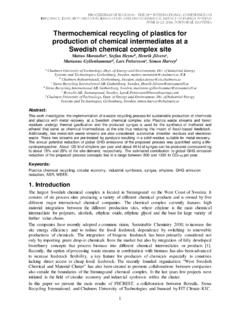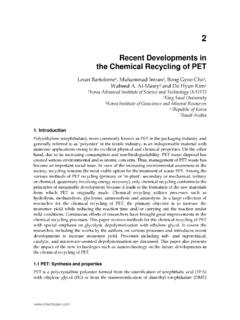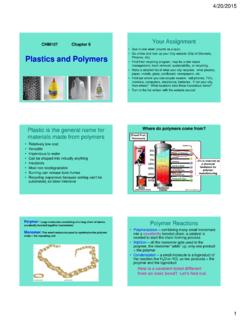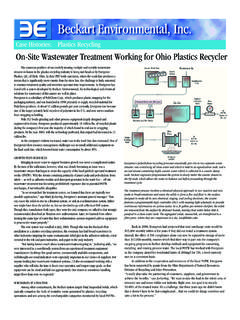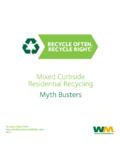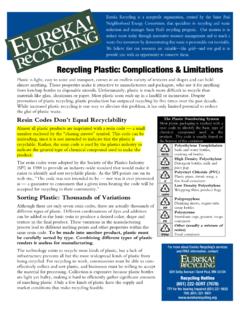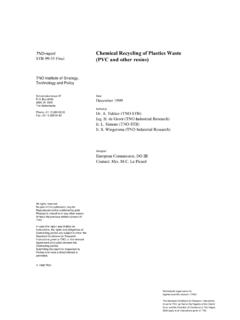Transcription of Recycling of plastics
1 Recycling of PlasticsImpEEIMPROVING ENGINEERING EDUCATIONPROJECTTHE 3 million tonnes of waste plastic are produced a year in the UK. 1 tonne = 20,000 plastic bottles 7% of this is recycled at present (2005) An estimated billion plastic bottles are disposed of each year 200,000 tonnes of plastic rubbish is being sent 8,000 miles to China each year for waste in the UKThings to think The basic raw materials for plastic are petroleum and/or natural gas. Although plastics only consume around 4% of the world s oil, supplies are becoming depleted. Many plastic products are reaching the end of their lifecycle, forming non-biodegradable mountains of waste plastic.
2 11% of household waste is plastic, 40% of which is plastic bottles Biologically produced plastics PHA , PHB and PLA are biologically produced. Processing energy is relatively high. More fossil fuel energy is used in their production than for both Polyethylene and PET. So renewable plastics are not necessarily as environmentally friendly as they first MaterialEnergy consumption of Biological versus Crude Oil derived plasticsFossil Fuel Requirement[MJ/kg of plastic]Assessing embodied energy and CO2 The energy input during manufacturing is not calculated via thermodynamics because: Industrial processes have varying efficiencies ranging from a few % to about 50% The scrap-fraction ranges from a few % to 80% or more Some part of the energy to heat, light and maintain the plant must be included In any new enterprise there is an energy mortgage to be paid the energy it cost to build the plantInstead it is calculated by input-output analysisProduction plantEnergy in (MJ/hour)Products out (n/hour)Energy/product = Energy in/Products outAssessing embodied energy and CO2 of plasticsOil derivatives (with embodied energy)PET production plantTotal plant energy(inc.)
3 Transport, heat, )Energy mortgage Bottleblow-moldingplantTotal plant energy(inc. transport, heat, )Energy mortgage PET granules (with aggregated embodied energy)EXAMPLE: primary production of PET bottlesEnergy/bottle = number of bottles out total energy inEnergy/kg PET = kg of PET out total energy inLife-Cycle Analysis In addition to the energy embodied in the plastic during production and manufacturing, products also require energy during use and disposal. An analysis that considers this whole process is referred to as life-cycle analysis. The next slide shows the results of such an analysis of a plastic drink breakdown for PE bottleGlassPEPETAluSteelContainerTypeMas s[g]32538252045 Mass/volume[g/litre]433386245102 Energy/Mass[MJ/kg]14808420023 Energy/Volume[MJ/litre] per unit of functionFunction: contain 1 litre of fluidRecycling changes the picture a little but not simpleThe winner is losers are glass and to think about plastics are not necessarily the waste and energy culprits that some people think they are.
4 plastics can be very energy efficient. It takes less energy to manufacture a plastic ketchup bottle than a glass ketchup bottle. And since plastics are lightweight, it takes less energy to transport a truckload of plastic ketchup bottles than a truckload of glass ketchup bottles. Up to 40% less fuel is used to transport drinks in plastic bottles compared to glass bottlesWhy recycle ? In landfill, both synthetic and naturally occurring polymers don t get the necessary exposure to UV and microbes to degrade. Here they are taking up space and none of the energy put into making them is being of tip. Why recycle ? Reclaiming the energy stored in the polymers can be done through incineration, but this can cause environmental damage by release of toxic gases into the atmosphere.
5 Recycling is a viable alternative in getting back some of this energy in the case of some polymers. As petroleum prices increase it is becoming more financially viable to recycle polymers rather than produce them from raw of polymers: the realityWhy, if Recycling is energy-efficient? And is it? Collection is time-intensive, so expensive Sorting of mixed plastic waste is difficult contamination is inevitable. Removing labels, print, all but impossible at 100% success rate Contamination of any sort compromises re-use in hi-tech applications (a carbonated water bottle is a pressure vessel a failure is unacceptable to the supermarkets that sell them) In-house scrap (generated at the source of production) is near-100% recycled consequence: most plastic (apart from in-house) is reused in lower-grade applications PET: cheap carpets, fleeces PE and PP: block board, park benchesRecycling of used plastics (here PET bottles): few plastic Recycling plants make a profit.
6 Many have closed. PET and PVC have many problems with cross contamination as the two polymers appear very similar to the naked eye and share the same specific gravity so cannot be separated by conventional float-sink techniques used in the plastic Recycling industry. The correct separation of plastics is extremely important. Just one PVC bottle in a batch of 10,000 PET bottles can ruin the entire melt! Problems with Recycling plasticsEnergy (and use) audit of Recycling of PETUsed plastic bottles (inc. collection transport energy)Polymersorting, cleaning, dicing, packaging plantTotal plant energy(inc. transport, heat, )Energy mortgage Recycled PET granules (with aggregated embodied energy -- and contaminates)Plant for use of recycled PETE nergy mortgage Total plant energy(inc.)
7 Transport, heat, )kg of fleece outEnergy per kg of fleece = kg of fleece out total energy inEnergies and prices of virgin and recycled plastics CommodityplasticsEmbodied energy, virgin material (MJ/kg)Price*,virgin material ($/kg)Embodied energy, recycled material (MJ/kg)Price*,recycled material ($/kg)HDPE77 - 35 - - 35 - - 60 - - 40 - - 35 - *Spot prices, November 2005 The messages: Both the embodied energy and price of recycled plastics are about half that of virgin material The lower price reflects the lower quality of the recycled material, limiting its use Because of this the contribution of Recycling to current plastic consumption is smallRecycling of polymers: the reality012345 HDPEPPPETPSPVCV irgin ProductionRecycled ProductionBecause of the problems outlined on the previous slides, the contribution of Recycling to current plastic consumption is production (millions of tonnes / year)Things to think about?
8 Since most oil is extracted to be burned directly as fuel, is it so wrong to turn it into plastic first, and then burn it to recover the energy?Things to think about China drives the global waste trade, importing more than 3 million tonnes of waste plastic a year. Western plastic companies are setting up in China, but some of the poorest people are employed to sort and recycle the plastic. Is it better to send rubbish to China to be recycled than to put it in landfill in Britain? How plastics are sortedHow the Recycling recyclables can be collected from individual homes or from collection points such as tips, schools and supermarkets. After transport to the Recycling plant, plastics are hand sorted according to their Recycling code.
9 Some materials recovery facilities can mechanically sort different plastic codes. Each plastic type is processed separately. How the Recycling plastic is sliced into flakes and the flakes go through a washing process. clean plastic flakes are melted together, extruded through small holes, and chopped into pellets. How the Recycling bags of recycled plastic pellets are taken to factories where they are melted and made into new products. the case of soft drink bottles the recycled pellets are combined with virgin material fresh from petroleum. These are then melted and moulded into preforms. How the Recycling bottles are blown into another mould to form the full size bottle this is often done at the bottling plant where they are filled and sealed.
10 Consumed they are delivered back to the Recycling plant after household Statistics4%3%5%16%15%Fiber57%FiberStrap pingFood/Beverage ContainersNon-Food containersFilm SheetOtherWhere Recycled PET Ends UpOther includes: Compounded Resin (2%), Tolled (1%), Clean Export (1%) A different It takes one day to collect a kilo of thin plastic bags from a tip by hand For one kilo, the rag picker typically earns in India Some cities in India are banning the use of thin plastic bagsImpEE is based at the Department of Engineering at the University of Cambridge and is funded by the CMI Institute. University of Cambridge, 2005 This material was produced as a part of the ImpEE Project at the University of Cambridge.


